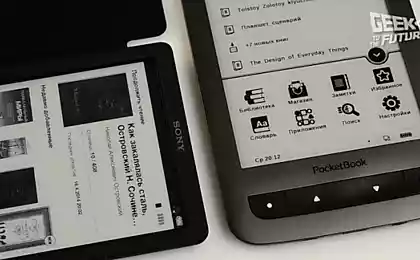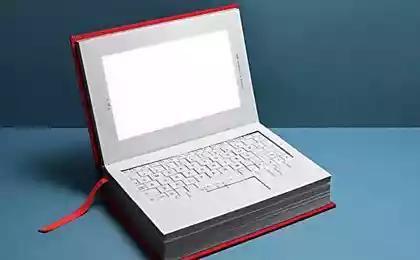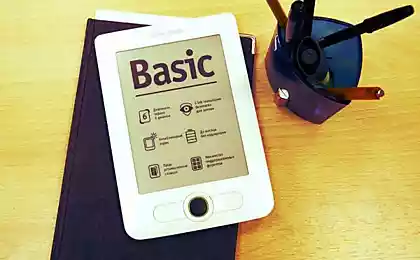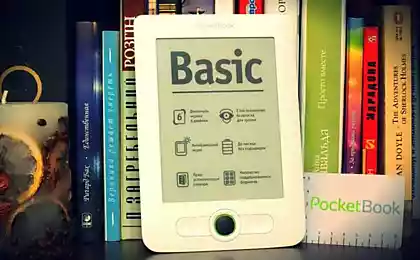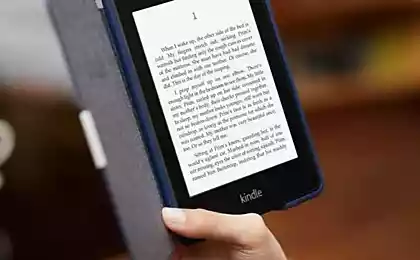673
Environmentally friendly e-books
In 2009, the year the Environmental Council of the book-publishing industry (BIEC) has set a goal to reduce the impact of the printing industry in the USA on global warming by reducing its carbon footprint by 20% (to 2020mu year), and then 80% (2050му). At the time these commitments products the Kindle and Nook were just starting to conquer the market, and e-books accounted for only 5% of sales.
Since then much has changed – today the world's leading companies, caring about the environment, abandon a "paper dependence" and adopting digital technology. So, in the standard signing letters Oxford University Press contains a request to "save paper and print only the necessary."
Eighty five million nine hundred eighty six thousand seven hundred sixty
E-books become more popular every day. At the end of the 2011 Amazon sold a million copies on Kindle every month, and Apple has managed to release 40 million iPads. Thus, selling e-books in the United States by the beginning of this year has increased to 31%. According to some, a happy owner of a e-book or tablet in the United States is one in four among College students – one-third.
The convenience and utility of electronic literature are such that some analysts predict the displacement of its literature paper. However, if she's as green as we would like to think, and bring the ubiquity of e-readers and tablets, the results expected by the professionals BIEC?
If we take the situation as a whole, with the continuous growth of the world population grows and the number of used books. The most active consumers of e-readers today are the USA, Australia, India and the UK. However, low income, lack of access to the Internet and digital technologies prevent the spread of innovations in other countries and worldwide sales of e-books compared to paper remains very small.
Forty one million nine hundred eighty nine thousand eight hundred sixty two
In addition, with the increasing demand for electronic and paper books is growing and the amount of materials required for their production, transportation and storage. In the case of electronic books, however, these costs include many components, traditionally (and erroneously) considered to be a process, not a book-publishing sphere.
Not so long ago National Geographic correspondent Allen Tellis expressed support for readers, explaining that "the environment should benefit from the spread of e-books due to lower use of paper and ink, and also cutting costs for transportation, storage and placement [of paper books]". He claims for damages caused to the environment during the production of the reader enough to read on it of 14 books; further its use and completely takes the reader into a plus. However, Tellis produces in mind the fact that the paper edition continues to be on a par with the electronic. It turns out that today readers does not reduce the ecological footprint of the book industry, but only add to it your own.
Forty five million eight hundred sixty eight thousand six hundred forty one
Assessment of the situation by journalists of the New York Times is somewhat different: according to them, the "eco-footprint one reader... is approximately equal to 40-50 trail [paper] books. In terms of global warming, it increases to 100 books".
Meanwhile, research Ted Genoway showed that currently the average duration of the use of readers does not exceed two years, after which people change them for the new improved model. It turns out that to achieve "eco-neutrality" ten million e-readers released to the American market next year, will replace the 250 million new publications. Given the fact that over the past year, the US has sold more than 25 million paper books, environmental damage from reading has increased tenfold.
Even worse is the situation with tablets is in order to charge the iPad on the time required to read one book, you need to burn 50 times more coal than is required to provide electrical lighting her paper copy for the same period. According to the Apple eco-the effect of hours of work iPad is comparable to the emissions of 2.5 grams CO2.
The comparison is carried out taking into account an average read speed of books the average resident of the United States in paper and electronic form (using the iPad) has shown that the carbon footprint of tablet use for the year is five times higher than that of paper books. Over time, the gap is reduced, and after five years (or for the reading of 32.5 books on one tablet) disappears altogether. However, if we take into account the above mentioned statistics (change device every 2 years), we find that the carbon footprint of one tablet initially 200-250% more than the trail of a classic library.
Ninety six million eight hundred six thousand nine hundred sixty eight
It should be noted that the classical readers with "electronic ink" designed exclusively for reading, consume less electricity, longer holding a charge and rarely become obsolete. Unfortunately, many people are looking for is not "a library in your pocket", and a generic device, with which you can mail to watch and games to play. Meets this is far less eco-friendly tablet (which is, in fact, a miniature computer). However, the more complex the device, the greater the damage is to the nature of its production, and, not least, recycling. The list goes on: energy consumption of data centers Amazon and Apple need charging and periodic replacement of the battery, and in case of breakage – and a reader/tablet, packing & shipping from abroad, as well as the fact that the electronic book device of the individual (the paper can be shared), did not say in its favor.
It is clear that technology does not stand still, and the process of digitization can not be reversed. However, producers should think about that or focus on developing new, greener readers, or ecologyinvest the process of creating the paper products (for example, active use of recycled materials). As for the current state of Affairs, we simply add new problems to the old.
What can readers do? A lot of options. You can buy books printed on recycled paper; share with friends; to have a season ticket in the nearest library. If the available literature is not enough (and avid readers can't get enough of), no electronic devices can not do. But here you can choose just to buy a tablet to read books on it, senselessly with the same success it is possible to damage the eye before the home monitor, and power it consumes much more of the reader.
And finally, what would you choose — remember that electronic devices are very poorly "digested" by nature. Do not rush to throw them away! Don't try to keep up with the development of technology, buying an all-new model. Use the device "to stop", and if the temptation is too much, try to give away or sell the old reader is the one who will use it. Simply put, you're not going to buy a new edition of the same experience, just because you liked its cover? So why are we trying to do with the device, from an environmental point of view is fifty books combined?
Source: /users/104
Since then much has changed – today the world's leading companies, caring about the environment, abandon a "paper dependence" and adopting digital technology. So, in the standard signing letters Oxford University Press contains a request to "save paper and print only the necessary."
Eighty five million nine hundred eighty six thousand seven hundred sixty
E-books become more popular every day. At the end of the 2011 Amazon sold a million copies on Kindle every month, and Apple has managed to release 40 million iPads. Thus, selling e-books in the United States by the beginning of this year has increased to 31%. According to some, a happy owner of a e-book or tablet in the United States is one in four among College students – one-third.
The convenience and utility of electronic literature are such that some analysts predict the displacement of its literature paper. However, if she's as green as we would like to think, and bring the ubiquity of e-readers and tablets, the results expected by the professionals BIEC?
If we take the situation as a whole, with the continuous growth of the world population grows and the number of used books. The most active consumers of e-readers today are the USA, Australia, India and the UK. However, low income, lack of access to the Internet and digital technologies prevent the spread of innovations in other countries and worldwide sales of e-books compared to paper remains very small.
Forty one million nine hundred eighty nine thousand eight hundred sixty two
In addition, with the increasing demand for electronic and paper books is growing and the amount of materials required for their production, transportation and storage. In the case of electronic books, however, these costs include many components, traditionally (and erroneously) considered to be a process, not a book-publishing sphere.
Not so long ago National Geographic correspondent Allen Tellis expressed support for readers, explaining that "the environment should benefit from the spread of e-books due to lower use of paper and ink, and also cutting costs for transportation, storage and placement [of paper books]". He claims for damages caused to the environment during the production of the reader enough to read on it of 14 books; further its use and completely takes the reader into a plus. However, Tellis produces in mind the fact that the paper edition continues to be on a par with the electronic. It turns out that today readers does not reduce the ecological footprint of the book industry, but only add to it your own.
Forty five million eight hundred sixty eight thousand six hundred forty one
Assessment of the situation by journalists of the New York Times is somewhat different: according to them, the "eco-footprint one reader... is approximately equal to 40-50 trail [paper] books. In terms of global warming, it increases to 100 books".
Meanwhile, research Ted Genoway showed that currently the average duration of the use of readers does not exceed two years, after which people change them for the new improved model. It turns out that to achieve "eco-neutrality" ten million e-readers released to the American market next year, will replace the 250 million new publications. Given the fact that over the past year, the US has sold more than 25 million paper books, environmental damage from reading has increased tenfold.
Even worse is the situation with tablets is in order to charge the iPad on the time required to read one book, you need to burn 50 times more coal than is required to provide electrical lighting her paper copy for the same period. According to the Apple eco-the effect of hours of work iPad is comparable to the emissions of 2.5 grams CO2.
The comparison is carried out taking into account an average read speed of books the average resident of the United States in paper and electronic form (using the iPad) has shown that the carbon footprint of tablet use for the year is five times higher than that of paper books. Over time, the gap is reduced, and after five years (or for the reading of 32.5 books on one tablet) disappears altogether. However, if we take into account the above mentioned statistics (change device every 2 years), we find that the carbon footprint of one tablet initially 200-250% more than the trail of a classic library.
Ninety six million eight hundred six thousand nine hundred sixty eight
It should be noted that the classical readers with "electronic ink" designed exclusively for reading, consume less electricity, longer holding a charge and rarely become obsolete. Unfortunately, many people are looking for is not "a library in your pocket", and a generic device, with which you can mail to watch and games to play. Meets this is far less eco-friendly tablet (which is, in fact, a miniature computer). However, the more complex the device, the greater the damage is to the nature of its production, and, not least, recycling. The list goes on: energy consumption of data centers Amazon and Apple need charging and periodic replacement of the battery, and in case of breakage – and a reader/tablet, packing & shipping from abroad, as well as the fact that the electronic book device of the individual (the paper can be shared), did not say in its favor.
It is clear that technology does not stand still, and the process of digitization can not be reversed. However, producers should think about that or focus on developing new, greener readers, or ecologyinvest the process of creating the paper products (for example, active use of recycled materials). As for the current state of Affairs, we simply add new problems to the old.
What can readers do? A lot of options. You can buy books printed on recycled paper; share with friends; to have a season ticket in the nearest library. If the available literature is not enough (and avid readers can't get enough of), no electronic devices can not do. But here you can choose just to buy a tablet to read books on it, senselessly with the same success it is possible to damage the eye before the home monitor, and power it consumes much more of the reader.
And finally, what would you choose — remember that electronic devices are very poorly "digested" by nature. Do not rush to throw them away! Don't try to keep up with the development of technology, buying an all-new model. Use the device "to stop", and if the temptation is too much, try to give away or sell the old reader is the one who will use it. Simply put, you're not going to buy a new edition of the same experience, just because you liked its cover? So why are we trying to do with the device, from an environmental point of view is fifty books combined?
Source: /users/104


